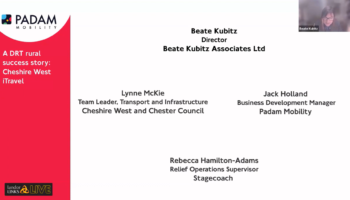Free floating, pooling rate, virtual line… The transport lexicon is rich and varied. And because sharing is part of our DNA, here are some definitions that will help you deepen your knowledge of this sector, including shared mobility.
Transport glossary: the basics of public transport
Shared mobility: consists of a means of transport that several users can either use at the same time (carpooling, bus, Demand-Responsive Transport…) or share its use individually, such as bicycles, scooters, etc.
Intermodality: refers to the combination of several means of transport to make a trip. For example, a person living on the outskirts of a city can take the bus to the station, then a train to the city centre.
Structural transport: refers to a public transport network whose service influences the organisation and development of an area. It is said to be a structuring network when it meets most of the transport needs of a population (range of hours, speed, capacity, etc.).
Conventional transport: is a term used in opposition to new forms of transport such as car-pooling, DRT, car-sharing etc.
Sustainable mobility: refers to all non-motorised means of transport. This includes cycling, walking, scootering, or any type of collective transport, or not, that has no CO2 emissions.
First and last kilometre (or mile): this refers to the first or last section of a journey.
Transport glossary: the case of Demand-Responsive Transport
Dynamic Demand-Responsive Transport: It’s an on-demand transport where the route is defined in real time, depending on the reservations. This form of DRT leaves the door open to last-minute bookings. Dynamic DRTgenerally works thanks to an algorithm that allows reservations to be dispatched and journey times to be calculated.
Free floating: a vehicle is in free floating mode when it circulates freely in a zone without following a precise line.
Virtual line: this is a classic line, but with only a few stops served, depending on the reservations.
Feeder line: A feeder line is a line that serves a particular stop at a specific time. This is the case when it is desired to match the drop-off time at a station with the arrival time of the train.
Door-to-door: A door-to-door service model refers to the possibility of pick-up and drop-off at any point within a defined area. This model is similar to the taxi model.
Multi-territory: this refers to the possibility of offering a Demand-Responsive Transport service in several distinct territories (each with its own specific characteristics) on a single booking platform.
Trigger threshold: this is the booking threshold below which a DRT service cannot start its route.
Transport glossary: let’s talk technology!
SaaS: for Service as a Software, is a software that is installed on a remote server rather than on the user’s computer. This form of software allows for rapid deployment as well as savings in acquisition and maintenance costs.
Ticketing: refers to all the tools used to manage transport tickets.
Trip planner: a tool used to determine the most appropriate route based on route calculation algorithms, with different specificities, in order to improve the journey planning experience.
MaaS: for Mobility as a Service, is a concept that aims to bring together all modes of travel in a single application. This service does not include the personal vehicle, since the interest of MaaS is to limit its use as much as possible. MaaS thus provides access to multimodality and intermodality in a fluid and coherent way, whether for a short or long journey.
Passenger information system: is a tool that aims to facilitate the daily life of transport operators. The focus is on optimising the links between the operators and the network, in order to improve the management and regularity of transport.
Transport glossary: the importance of key performance indicators
Pooling: is an indicator that measures the filling of vehicles by users. It is particularly relevant to get an idea of the success of shared mobility.
Conversion rate: all indicators related to the different conversion rates between searches, trip proposals and reservations made. These indicators give a precise idea of the volume of searches leading to a booking and the relevance of the journey proposals made to users.
Quality of service: indicators that give an idea of how the service is perceived by users through the ratings given to the service and the driver.
This article might interest you: Demand-Responsive Transport: explore and leverage the data generated by your service





